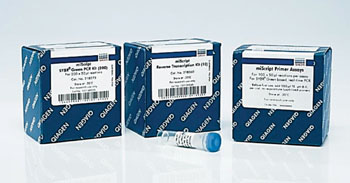MicroRNAs Predict Disease Progression in Brain Tumors
By LabMedica International staff writers
Posted on 07 Jul 2016
A new method has been developed of predicting disease progression in glioblastoma patients who have undergone standard treatment and multimodal therapy of glioblastoma (GBM) reveals inter-individual variability in terms of treatment outcome.Posted on 07 Jul 2016
During the last years, micro ribonucleic acid (miRNAs) have increasingly received attention, with a high degree of promiscuity miRNAs target and regulate several messenger RNA (mRNA) species encoding for proteins involved in various signaling pathways. Accumulating evidence indicates that miRNA expression signatures can serve as biomarkers for diagnosis and risk assessment of diverse malignancies, including GBM.

Image: The miScript primer assays and PCR kits (Photo courtesy of Qiagen).
Scientists at the Helmholtz Zentrum München (Neuherberg, Germany) and their colleagues examined formalin-fixed paraffin embedded (FFPE) sections from 36 GBM patients along with overall survival follow-up were collected retrospectively and subjected to miRNA signature identification from microarray data. For independent validation, the miRNA expression dataset from an age- and sex-matched subset of 58 individuals and of the 357 on The Cancer Genome Atlas (TCGA) GBM cohort was used.
Genes potentially regulated by the signature miRNAs were identified by a correlation approach followed by pathway analysis. MiRNA analysis was carried out using the Geniom Biochip MPEA homo sapiens biochips containing 1,223 miRNA probes (Comprehensive Biomarker Center, Heidelberg, Germany). MiScript primer assays (QIAGEN Sciences, Germantown, MD, USA) for the four miRNAs of the signature were used for relative quantification along with a reference assay for the small RNA SNORD6.
The scientists found a prognostic 4-miRNA signature, independent of O6-Methylguanine-DNA methyltransferase (MGMT) promoter methylation, age, and sex, was identified and a risk score was assigned to each patient that allowed defining two groups significantly differing in prognosis. The signature was technically validated by quantitative real time polymerase chain reaction (qRT-PCR) and independently validated in an age- and sex-matched subset of standard-of-care treated patients of the TCGA GBM cohort.
Kristian Unger, PhD, the lead investigator of the study, said, “To date only few prognostic and predictive factors for glioblastoma have been identified. Our method could be used to identify candidates for alternative or intensified treatment options, as it is highly unlikely that patients with a high risk score would benefit from standard therapy.” The study was published on June 11, 2016, in the journal Oncotarget.
Related Links:
Helmholtz Zentrum München
Comprehensive Biomarker Center
QIAGEN Sciences














